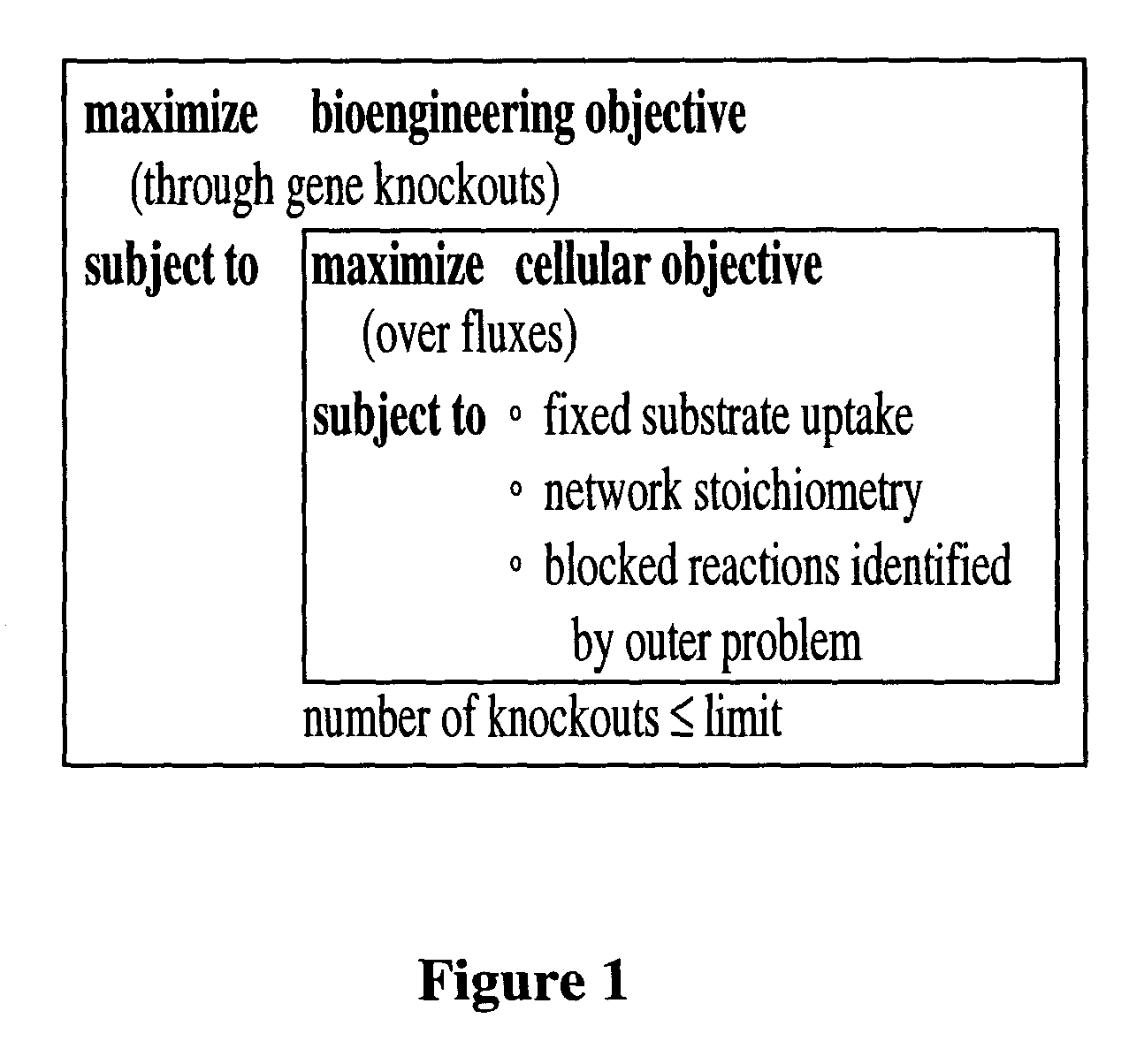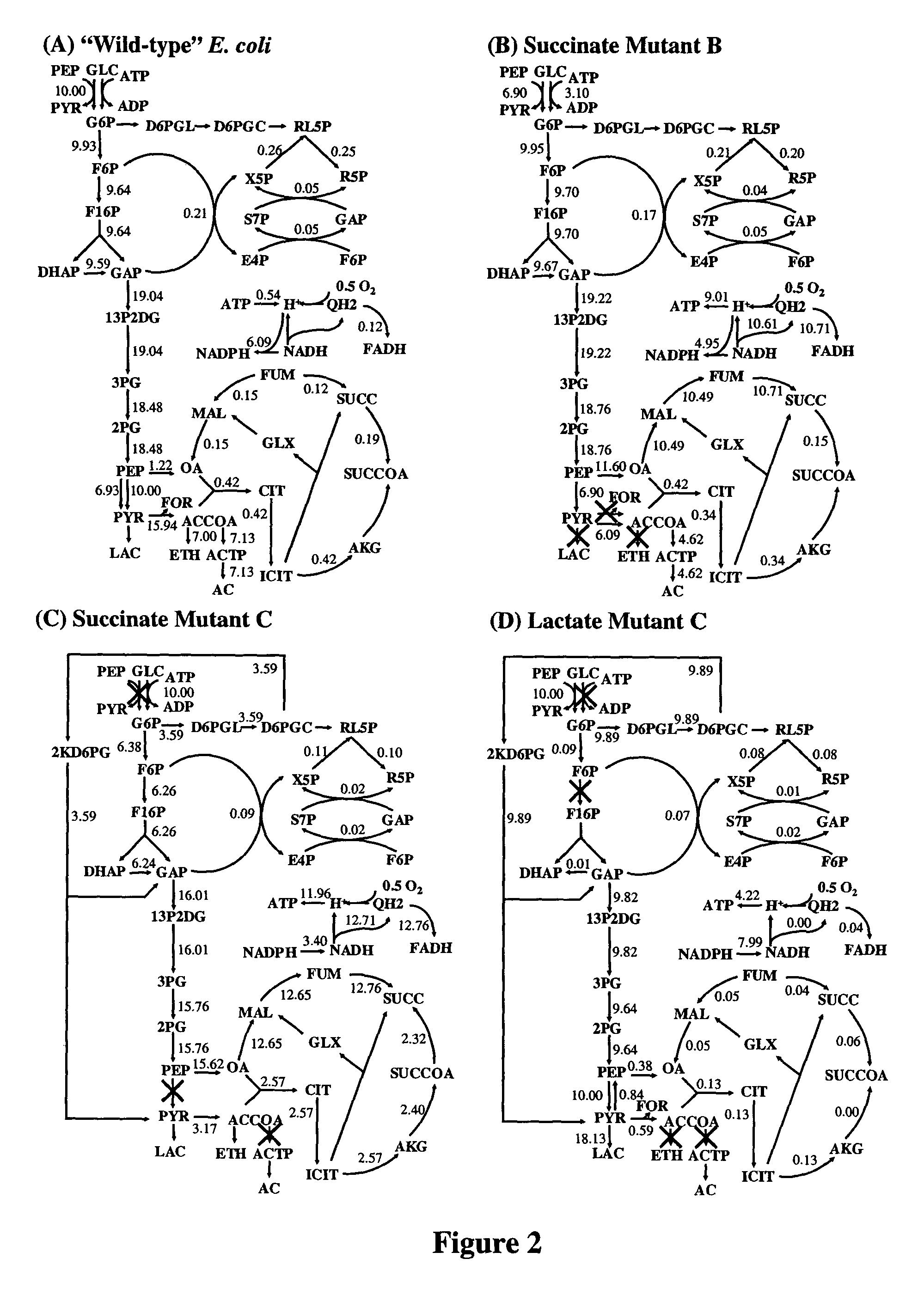Method for determining gene knockouts
- Summary
- Abstract
- Description
- Claims
- Application Information
AI Technical Summary
Benefits of technology
Problems solved by technology
Method used
Image
Examples
example 1
Succinate and Lactate Production
[0038]Which reactions, if any, that could be removed from the E. coli K-12 stoichiometric model (Edwards and Palsson, 2000) so as the remaining network produces succinate or lactate whenever biomass maximization is a good descriptor of flux allocation were identified. A prespecified amount of glucose (10 mmol / gDW·hr), along with unconstrained uptake routes for inorganic phosphate, oxygen, sulfate, and ammonia are provided to fuel the metabolic network. The optimization step could opt for or against the phosphotransferase system, glucokinase, or both mechanisms for the uptake of glucose. Secretion routes for acetate, carbon dioxide, ethanol, formate, lactate and succinate are also enabled. Note that because the glucose uptake rate is fixed, the biomass and product yields are essentially equivalent to the rates of biomass and product production, respectively. In all cases, the OptKnock procedure eliminated the oxygen uptake reaction pointing at anaerobi...
example 2
1,3-Propanediol (PDO) Production
[0043]In addition to devising optimum gene knockout strategies, OptKnock was used to design strains where gene additions were needed along with gene deletions such as in PDO production in E. coli. Although microbial 1,3-propanediol (PDO) production methods have been developed utilizing glycerol as the primary carbon source (Hartlep et al., 2002; Zhu et al., 2002), the production of 1,3-propanediol directly from glucose in a single microorganism has recently attracted considerable interest (Cameron et al., 1998; Biebl et al., 1999; Zeng and Biebl, 2002). Because wild-type E. coli lacks the pathway necessary for PDO production, the gene addition framework was first employed (Burgard and Maranas, 2001) to identify the additional reactions needed for producing PDO from glucose in E. coli. The gene addition framework identified a straightforward three-reaction pathway involving the conversion of glycerol-3-P to glycerol by glycerol phosphatase, followed by...
example 3
Alternative Cellular Objective
Minimization of Metabolic Adjustment
[0048]All results described previously were obtained by invoking the maximization of biomass yield as the cellular objective that drives flux allocation. This hypothesis essentially assumes that the metabolic network could arbitrarily change and / or even rewire regulatory loops to maintain biomass yield maximality under changing environmental conditions (maximal response). Recent evidence suggests that this is sometimes achieved by the K-12 strain of E. coli after multiple cycles of growth selection (Ibarra et al., 2002). In this section, a contrasting hypothesis was examined (i.e., minimization of metabolic adjustment (MOMA) (Segre et al., 2002)) that assumed a myopic (minimal) response by the metabolic network upon gene deletions. Specifically, the MOMA hypothesis suggests that the metabolic network will attempt to remain as close as possible to the original steady state of the system rendered unreachable by the gene...
PUM
| Property | Measurement | Unit |
|---|---|---|
| Time | aaaaa | aaaaa |
| Time | aaaaa | aaaaa |
| Time | aaaaa | aaaaa |
Abstract
Description
Claims
Application Information
 Login to View More
Login to View More - R&D
- Intellectual Property
- Life Sciences
- Materials
- Tech Scout
- Unparalleled Data Quality
- Higher Quality Content
- 60% Fewer Hallucinations
Browse by: Latest US Patents, China's latest patents, Technical Efficacy Thesaurus, Application Domain, Technology Topic, Popular Technical Reports.
© 2025 PatSnap. All rights reserved.Legal|Privacy policy|Modern Slavery Act Transparency Statement|Sitemap|About US| Contact US: help@patsnap.com



